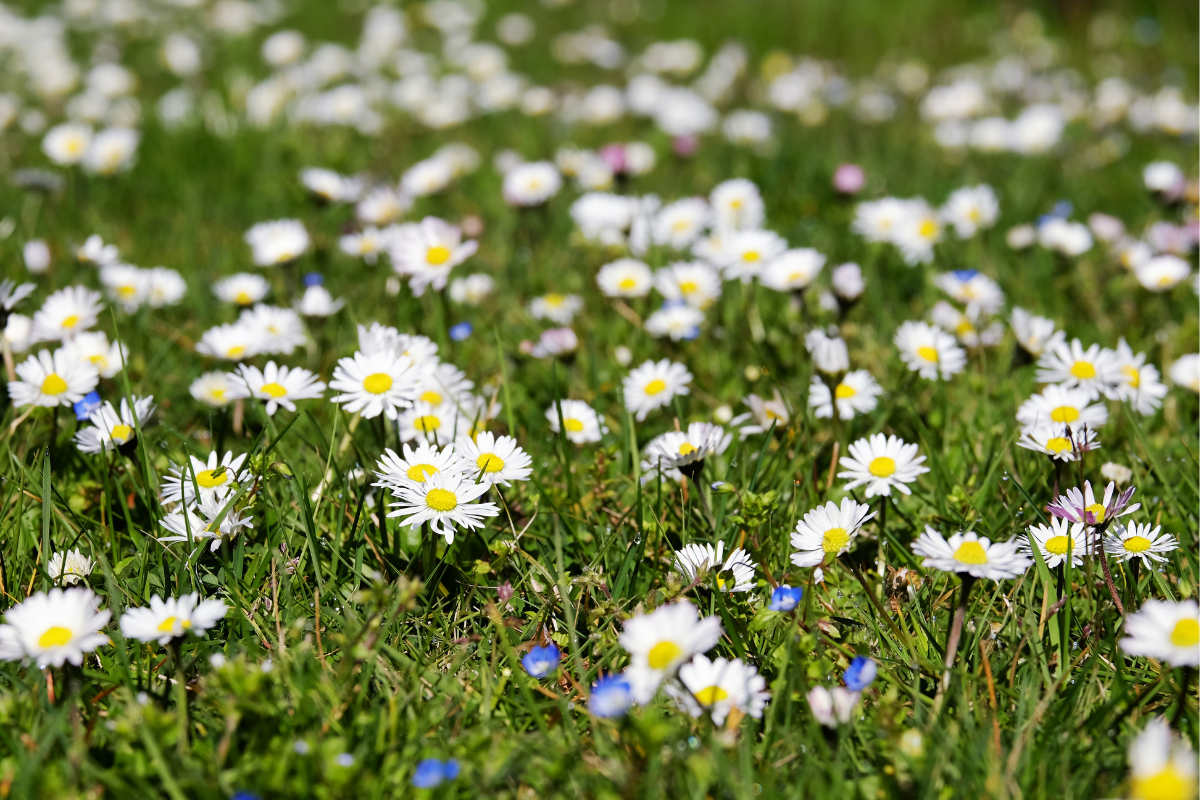

When we walk through meadows and fields or enjoy nature in our own garden, we often come across a fascinating variety of flowers and plants. One family stands out in particular: the composite family, also known as "Asteraceae". This diverse group of plants not only delights us with its colorful splendor, but also plays a crucial role in preserving our ecosystem. But that's not all: it also shapes our history with a special cultural significance.
In this article, we dive together into the colorful world of composite flowers.
Contents:
Botanical characteristics of the composite plants
Let's start with a look at the botanical characteristics of composite plants - the plant family whose grace and diversity have always captivated people. Although this family comprises around 24,000 species, composite plants do have some characteristics in common. Their flowers are typically arranged in a "basket" shape, with many small flowers coming together to form a large inflorescence - as we can see with tansy or yarrow. However, there are also composite flowers that consist of a single flower, as is the case with the sunflower.
Their leaves are usually arranged alternately and can be completely different in shape and size. The fruits are often so-called achenes, which are small, single-seeded fruits surrounded by a calyx. These fruits are often equipped with a pappus, a kind of flying umbrella that helps them to spread by the wind.
Well-known representatives of the aster family are the marigold (calendula), daisy, camomile, goldenrod, thistle and dandelion.
Distribution of composite plants
Compositae are not only characterized by their diversity, but also by their extraordinary adaptability. They are found all over the world and can be found in almost all climate zones - from tropical rainforests to arctic tundras. Some species have even adapted to extreme locations such as salt marshes or alkaline soils and are able to survive in the most adverse conditions.
Nevertheless, there are areas where we find a particularly large number of composite plants. These include
-
Temperate climate zones: Compositae are particularly widespread in Europe, North America and parts of Asia. Here they flourish both in the wild and in cultivated landscapes.
- Mediterranean regions: Many composite plants also thrive in the sun-drenched landscape around the Mediterranean and characterize the landscape's flora and fauna.
- Prairies and steppes: In the vast prairies of North America and steppes of Eurasia, composite plants often dominate the vegetation. They are adapted to dry conditions and play an important role in these ecosystems.

The history of the discovery of composite plants
Die Geschichte der Korbblütler reicht weit zurück und ist eng mit der Entwicklung der Botanik und der Naturwissenschaften verbunden. Denn bereits in der Antike begannen die Menschen, Pflanzen zu studieren und zu analysieren. Frühe griechische Philosophen, darunter Aristoteles , beschrieben Merkmale und Arten von Pflanzen wie den Korbblütlern. Später im Mittelalter wurden viele Pflanzen in Pflanzenbüchern dokumentiert , in denen ihre Merkmale und Verwendungszwecke festgehalten wurden.
Botany experienced a significant boom during the Renaissance and early modern times. Scientists such as Carl von Linné began to develop systematic classification systems for plants. This made it possible to assign scientific names to composite plants and categorize them into different groups.
In the 18th and 19th centuries, many scientists undertook research tours during which they discovered and documented numerous new species of composite plants. Significant scientific successes were achieved in the course of the 20th century. This made it possible for researchers to study and understand the structure, function and evolution of composite plants in more detail.
Today, researchers use modern technologies and methods to analyze the genetics, ecology and biology of composite plants in greater detail. Constant advances in biotechnology enable researchers to continually discover new areas of application for this special plant family.
Cultural significance of composite plants
The history of composite flowers has a strong cultural influence. Since they have accompanied us humans on our journey, we have assigned them special meanings. For example, they have a symbolic meaning in many cultures and are often associated with certain characteristics or ideas. A vivid example of this is the sunflower, which in ancient Greece was associated with the sun god Helios and symbolized light, strength and fertility. In other cultures, too, various composite flowers were associated with positive characteristics and were part of traditional customs, ceremonies and festivals.
Many artists and writers have also been inspired by the beauty and diversity of composite flowers. Their bright colors and unusual shapes made them an ideal subject for works of art, paintings, poems and stories. For example, the poem "Daisy" by William Wordsworth. Here the poet writes about the beauty and simplicity of the daisy and reflects on the transience of life.
Ecological importance of composite plants
However, composite plants have not only always played an important role for us humans - they are also indispensable for the prevailing ecosystem. There are various reasons for this:
-
Pollination: In order to reproduce, many composite flowers are dependent on pollinating insects such as butterflies, bees and beetles. To do this, they attract insects with their strikingly colored and pleasantly scented flowers and offer them food in the form of nectar and pollen. Through this interplay, they contribute to the survival of many insects and play a crucial role in various ecosystems.
- Food source: Compositae are an important food source for both pollinators and other animals. While insects mainly feed on their nectar and pollen, seeds and larger plant parts are eaten by birds and other small animals.
-
Soil improvement: Some composite plants, such as yarrow, have very deep roots. As a result, they loosen the soil and improve the soil structure. This promotes the fertility and quality of the soil and at the same time supports the growth of other plants in its vicinity.
-
Habitat: Many composite plants provide a natural habitat for insects and other invertebrates such as snails, spiders and woodlice.
-
Natural pest control: Some composite plants produce natural pesticides to protect themselves from pests. This can help to maintain the ecological balance in agricultural systems.
Preserving and protecting biodiversity
Compositae undoubtedly play an important role in our prevailing ecosystem. Unfortunately, many of them are already threatened with extinction and are under special protection - such as the arnica in the Alpine region of Europe.
But what can we actively do to help protect composite plants? Here are some ideas on how you can help protect this valuable plant family:
-
Preserve natural habitats: We can all get involved in preserving natural habitats. This process ranges from private walks in the woods, where we make sure to leave as little trace as possible, to membership in nature conservation organizations or participation in local political projects.
-
Design your garden close to nature: When designing your garden, patio or balcony, make sure it is close to nature. This means: plant more native composite plants or other insect favorites such as wildflowers, perennials and grasses. It is also beneficial if you do not meticulously control every inch of your garden. You will be doing our ecosystem the greatest favor if you leave the garden maintenance to nature, as far as you can.
-
Share your knowledge: Education is an important step towards a natural, environmentally conscious future. So pass on your knowledge whenever you can. Get your friends and acquaintances excited about small meadow projects and send your children on excursions with your local nature conservation association. Only in this way can we together contribute to a tomorrow in which people and nature live together in peaceful symbiosis.
Our favorite among the composite plants: Artemisia annua
Unter den Korbblütlern gibt es eine Pflanze, die es uns bei teemana besonders angetan hat: die Artemisia annua, auch bekannt als einjähriger Beifuß.
This fascinating plant originates from Asia, where it has been cultivated by people for centuries and valued for its properties. It has a wide range of different applications, including cosmetics and aromatherapy.
It is particularly well known for its extraordinary ingredient "artemisinin". This has increasingly become the focus of scientific attention in recent years - in 2015, the Chinese researcher Youyou Tu even won the Nobel Prize for its rediscovery and isolation.
We are enthusiastic about the great potential of this unique plant - we would love to share this enthusiasm with you. We would therefore like to invite you to discover this powerful plant in our range and see its extraordinary abilities for yourself.
Conclusion
→ There is no doubt that the composite plants are an impressive plant family that has always inspired us humans.
→ From their eye-catching flowers and beguiling scents to their symbolism and cultural significance, composite flowers have fascinated and inspired mankind for centuries.
Nevertheless, many of them are now threatened with extinction and need our help! Because their preservation is crucial so that your great-grandchildren can also enjoy the amazing diversity as we do today. Help protect this important plant family for future generations - so that they can continue to enrich us with their beauty.




